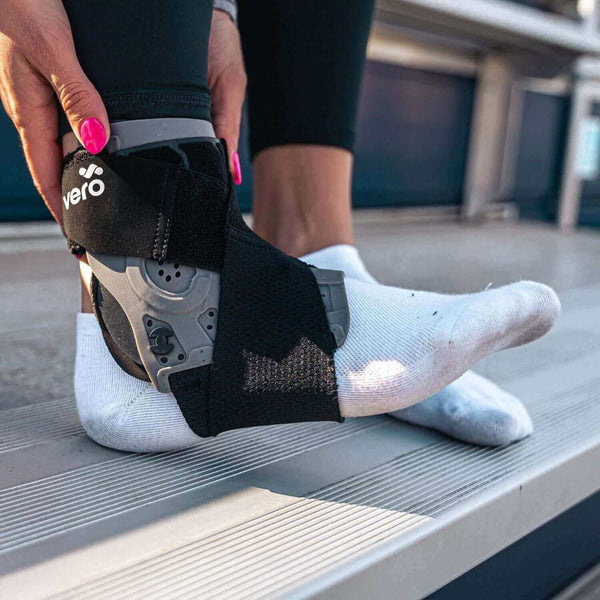Visiting with a physician can be stressful and uncomfortable. Often, the treating physician differs from the initial physician, so it’s important to consistently and effectively communicate the details of your ankle injury. This article will help you describe the nature, location, and possible reasons for persisting pain and discomfort, which, in turn, helps improve the likelihood of a successful recovery.
Provide Background on the Ankle Injury
It's essential that all records, not just the summary, are brought to the visit. Be sure to get the written record and any imaging, such as X-rays, to be brought to the appointment. This information is only sometimes available in the electronic health record (EHR). Here are some key examples of how to adequately provide background on your ankle injury.
Date of Injury
Begin by stating when the injury occurred. For example, "I sprained my ankle six weeks ago while stepping off a curb." The amount of time since the injury occurred can be extremely important for diagnosing and recovering.
Prior Injuries
Detail your history regarding injuries of this nature, even if you’re not sure if they’re related or not. For instance: “I have/have not sprained the ankle before, and compared to prior injuries, it is better/worse.” This helps the physician determine the cause of the injury, the likelihood of reinjury, and other important diagnostic factors.
Initial Symptoms
Describe the immediate symptoms you experienced after the injury. For example: "Immediately after the injury, my ankle swelled up, and I had difficulty bearing weight on it." This helps validate the diagnosis and helps to ensure more effective treatment plans.
Treatment Received
What did you try already? Include details on your treatment, such as RICE (Rest, Ice, Compression, Elevation), bracing, or physical therapy. For instance: "I applied ice, kept my ankle elevated, and used a compression bandage. I also wore an ankle brace for two weeks." If you did use an ankle brace or similar device, be sure to bring the brace with you for evaluation. Not all braces are the same, and this can help the treating physician determine why it may or may not have worked.
Current Symptoms
An ankle sprain is a common injury, but it is essential to articulate the problem clearly when healing does not progress as expected. Below are some examples of ways you can thoroughly describe the symptoms you’re experiencing.
Pain Description
Describe the pain you're currently experiencing. Is it sharp, dull, throbbing, or burning? Does it occur at rest, during activity, or both? For example: "I still feel a dull ache on the outer side of my ankle, which becomes a sharp pain when I try to walk or stand for more than 10 minutes."
Location of Pain
Specify where the pain is located. Use anatomical terms if you know them, or describe it as the inner or outer side of the ankle, front, back, or deep within the joint. For instance: "The pain is mostly on the outer side of my ankle, right below the bony bump." Be sure to mention any knee or foot pain as well.
Swelling or Stiffness
Note if there is any persistent swelling, stiffness, or warmth in the area. For example, a patient might say: "There is still some swelling around my ankle, especially in the evenings, and it feels stiff when I first wake up in the morning."
Impact on Daily Activities
It’s also essential to describe how the ankle injury is affecting your daily life. This helps the doctor to understand what types of activity you need to be able to perform, and how you can go about returning to your normal routines. Below are some examples:
Mobility Issues
Explain how the injury is affecting your ability to perform daily tasks. Example: "I'm finding it difficult to walk without limping, and I can't stand for more than X minutes without feeling pain."
Work and Exercise Limitations
Describe how the injury has impacted your work or exercise routine. Example: "I have not been able to return to my regular exercise routine, and even simple tasks like grocery shopping have become challenging."
Quality of Life
Discuss how the ongoing pain is affecting your overall well-being. Example: "The persistent pain is affecting my sleep and making me feel frustrated and anxious about my recovery."
Questions for the Doctor
When is Advanced Imaging, such as an MRI, Necessary?
Typically, plain radiographs are used for the initial screening. When the radiographs or the history and exam indicate an immediate need for advanced imaging, this may be ordered. Most sprains will resolve quickly; when they don't improve, advanced imaging will be obtained.
What is the Normal Recovery for an Ankle Sprain?
Every ankle injury is different, but a mild ankle sprain typically improves in 1-2 weeks. A moderate sprain usually is around 2-4 weeks. Lastly, severe sprains can often last 12 weeks or longer.
A Summary Checklist
- Bring all prior records to your appointment.
- Clearly describe the injury history and treatment to date.
- Point directly to the pain location and describe what causes the pain.
- During the exam, many structures will be pushed on (palpated); be clear when pain occurs or when it is absent.
- Explain your work and personal life concerns, including driving, walking, etc.
- Discuss your medical problems, including diabetes.
- Ask any questions you may have about upcoming procedures and the recovery process.
Persistent pain after an ankle sprain can be frustrating, but communicating your symptoms clearly to your physician is crucial to recovery. By providing detailed information about your injury history, treatment received, and current symptoms, you can help guide your doctor toward the most effective diagnosis and treatment plan. Contact us at Vero Ankle® to learn more about recovering from an ankle sprain, and try the Vero Ankle® brace today.
Disclaimer: This is not intended to provide an individual with patient care. No patient-physician relationship is created with this information.





















